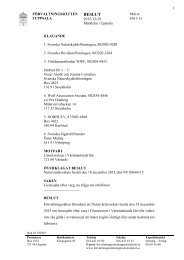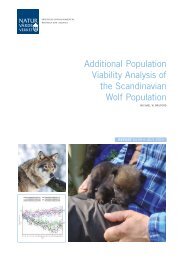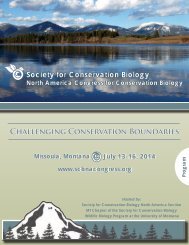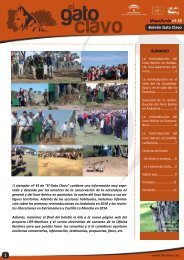1oC3Dbk
1oC3Dbk
1oC3Dbk
Create successful ePaper yourself
Turn your PDF publications into a flip-book with our unique Google optimized e-Paper software.
and associated Facebook pages and Twitter accounts as<br />
networking and information-sharing tools. The website serves<br />
as an information hub for researchers, conservation<br />
professionals and keen naturalists interested in the status of the<br />
world’s small mammals. It promotes the work of some of our<br />
global expert members investigating small mammal diversity<br />
and working in remote places around the world to save the most<br />
endangered species of small mammal. We started recruitment<br />
of 10 Regional Chairs who will help drive the development of the<br />
SMSG and ensure greater regional representation at the senior<br />
levels of the group.<br />
Finally, we are very grateful to the Durrell Wildlife<br />
Conservation Trust, the Texas A&M University and the<br />
Zoological Society of London for their generous support of the<br />
SMSG.<br />
Dr Richard Young and Dr Thomas E. Lacher, Jr<br />
Co-chairs, Small Mammal Specialist Group<br />
Snake and Lizard Red List Authority<br />
In 2013, the Snake and Lizard Red List Authority focused on<br />
reviewing IUCN Red List assessments resulting from Global<br />
Reptile Assessment (GRA) workshops, and on submitting<br />
species assessments with completed reviews, to The IUCN<br />
Red List. A key element of IUCN’s strategic plan is to increase<br />
the coverage of different taxonomic groups on The IUCN Red<br />
List.<br />
Just over 600 reptile species (including reassessments and<br />
a small number of corrected assessments) were added to The<br />
IUCN Red List in 2013, bringing the total number of reptiles on<br />
The IUCN Red List to over 4,000 (over 40% of the global total)<br />
for the first time. The majority of these species were included in<br />
the first IUCN Red List update in 2013, and included the<br />
majority of regional endemics from the 2012 GRA workshops<br />
on the reptiles of Central America and West Africa.<br />
Additionally, a number of recently-recognized, highly<br />
threatened skinks from the Caribbean were both assessed and<br />
reviewed through the RLA membership, and a moderate<br />
number of species with outstanding queries following 2011’s<br />
Western Ghats and Oceania workshops, were also added to<br />
The IUCN Red List; completing these regions for the GRA (with<br />
the exception of only individual species which remain under<br />
review).<br />
Philip Bowles<br />
Chair, Snake and Lizard Red List Authority<br />
Mexican Parrot Snake (Leptophis mexicanus). © Philip Bowles<br />
Lane Snapper (Lutjanus synagris). © D. Synder<br />
Snapper, Seabream, Grunt Specialist Group<br />
(SSG SG)<br />
Our mission is to achieve sustainable use and global<br />
conservation of snapper, seabream, grunt, and associated<br />
species through improved scientific knowledge, public<br />
awareness, and optimized management decision-making. The<br />
SSG SG is focused on completing IUCN Red List assessments<br />
of over 500 species, as well as diverse conservation needs<br />
and regional issues.<br />
IUCN Red List assessments are now being conducted for<br />
all snappers and grunts of the Mediterranean, East and West<br />
Atlantic, and Arabian (Persian) Gulf (Lutjanidae and<br />
Haemulidae, >80 species), as well as seabreams worldwide<br />
(Sparidae, 136 species) and smaller families. Our group<br />
members are currently working on Marine Protected Area<br />
(MPA) and regulatory initiatives in some regions, with a focus<br />
on conserving spawning aggregations using available data and<br />
traditional ecological knowledge from fishers. Regional Red<br />
Listing work includes European region (Mediterranean and<br />
Atlantic coast of Europe and E Atlantic islands of Spain and<br />
Portugal) – 30 species of Centracanthidae, Haemulidae,<br />
Sparidae, (drafts completed in 2013); Northwest Atlantic<br />
(Bahamas workshop in 2012); Eastern Atlantic (Ghana<br />
workshop in 2013) and Arabian (Persian) Gulf (Qatar workshop<br />
in 2013).<br />
Dr Barry Russell and Dr Ken Lindeman<br />
Co-chairs, Snapper, Seabream, Grunt Specialist Group<br />
South American Camelid Specialist Group<br />
(GECS)<br />
Our mission is to promote the conservation and sustainable<br />
use of (wild) South American Camelids in their area of<br />
geographic distribution.<br />
During 2013 we took part in several activities from the<br />
international to the national level. At the international level, we<br />
reviewed an IUCN/Traffic report on the transfer of the<br />
Ecuadorian population of Vicuña (Vicugna vicugna) from<br />
Appendix I to Appendix II. We participated at the IPBES<br />
meeting on Contribution of Indigenous and Local Knowledge<br />
Systems to IPBES: Building synergies with science. We<br />
participated at the XXX Meeting of the Vicuña Convention, held<br />
in Ecuador and contributed to the elaboration of resolutions.<br />
After the meeting, we maintained collaborations with the Pro-<br />
Specialist Groups, Task Forces and Red List Authorities<br />
83






